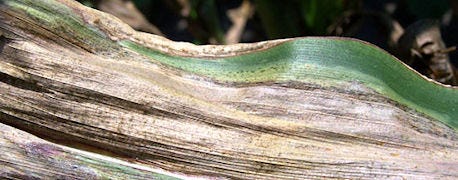April 18, 2012

In some areas of the Corn Belt, Goss's wilt has emerged as an economically important corn disease the past few years. In the hardest hit fields in Iowa and Nebraska, yield losses of more than 100 bushels per acre were reported. The disease is showing up in other states, too.
Goss's wilt is a foliar disease with large, gray to reddish cigar-shaped lesions usually starting on the upper corn leaves. Spraying corn with fungicides won't control it. Goss's wilt is caused by a bacterium, not a fungus. It's hard to say exactly why Goss's wilt was so severe last year. But widespread planting of corn hybrids susceptible to the disease is a prime factor.

New Product Promises to Prevent And/Or Cure Goss's Wilt Outbreaks
Current crop production practices are another reason the disease is appearing more often. There's more corn following corn, which favors a pathogen that survives in crop residue. "Several factors are involved and this isn't an easy disease to manage," says Alison Robertson, Iowa State University Extension plant pathologist.
Plant pathologists recommend planting corn hybrids that have resistance to Goss's wilt, using crop rotation such as corn-soybean instead of continuous corn and using crop residue management. However, they realize continuous corn is going to be grown, and with soil erosion a concern, you have to be careful with tillage if you try to manage Goss's wilt by burying crop residue. Be aware that even with tillage the bacteria can survive underground.
There is a new product on the market, Procidic, a broad-spectrum fungicide and bactericide combination. It's the only product labeled to control Goss's wilt and it is registered for use throughout the Corn Belt. University plant pathologists are testing Procidic this year in Iowa and Nebraska.
New broad-spectrum product
Procidic can be applied as a preventative treatment or a curative, says Steve Knauss, of Greenspire Global Inc., which markets Procidic. Knauss, based in Des Moines, says the product has all natural ingredients and doesn't cause stress to plants. There's no maximum number of applications and no rate restrictions on the amount that can be applied per year.
If you use the product to control fungal diseases along with bacterial diseases such as Goss's wilt, you could start with 2 ounces applied in-furrow. Or a 4 to 6-ounce rate sprayed on the corn at V3 to V5 growth stage, followed by a second application prior to tassel at the 8 to 10 ounce rate. In a worst case scenario, if you find Goss's in a field with severe infestation, Knauss says you may have to use Procidic at a higher rate up to 14 ounces per acre in a rescue situation. Continued scouting is recommended.
Procidic at a 6-ounce rate applied preventatively to young, growing corn plants would bring the cost more in line with fungicide applications. The product can also be used as a curative or rescue treatment. "Using Procidic as a curative or rescue treatment, we're trying to save yield and grain quality," says Knauss. If Procidic is applied at a 14-ounce rate the cost is about $33 an acre. If corn prices are $6 per bushel, and if you gain 5 to 6 bushels per acre by controlling the disease, that's the breakeven.
"A key benefit of Procidic is you are buying one product for the price of two," says Knauss. "It's a fungicide and bactericide; it controls other corn diseases in addition to Goss's wilt." The label says Procidic controls anthracnose, southern and northern corn leaf blight, fusarium wilt, gray leaf spot and others. It is also labeled to control certain diseases of soybeans, alfalfa, wheat and rice.
Offers timing flexibility
Procidic works on contact and is rapidly absorbed into the plant to work systemically, too, says Knauss. When you see disease pressure present on corn plants you need to use a higher rate and shorter intervals between spraying. Rates and instructions for use depend on timing of application.
Goss's wilt can remain in a field on infected crop residue for years. Knauss suggests using the preventative approach for best results. "Growers have lost anywhere from 10 to 20 to 100 bushels per acre from Goss's wilt if it shows up in a cornfield and is not treated," says Knauss. "The past few years in working with this product we've seen very positive results. Procidic works." While it is new to the U.S. Corn Belt, the product has been used abroad for the past 25 years for control of bacterial and fungal diseases in many fruit and vegetable crops.
For more information visit www.greenspireglobal.com.
About the Author(s)
You May Also Like






